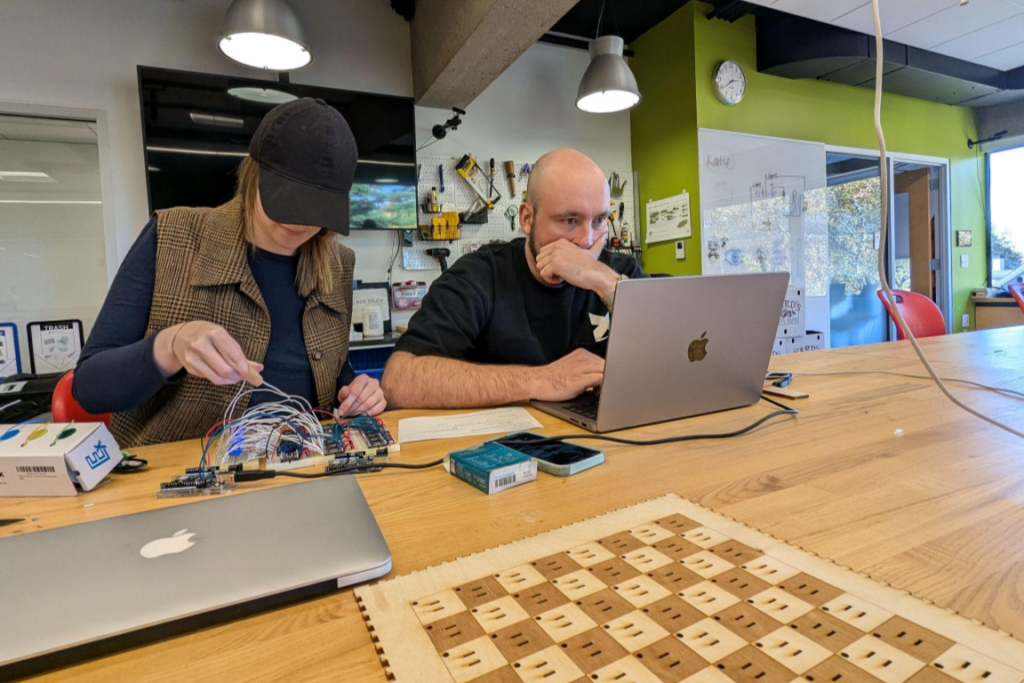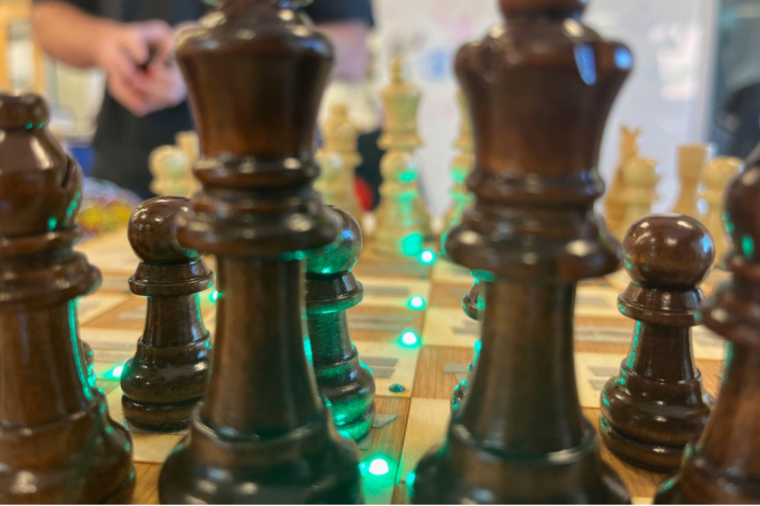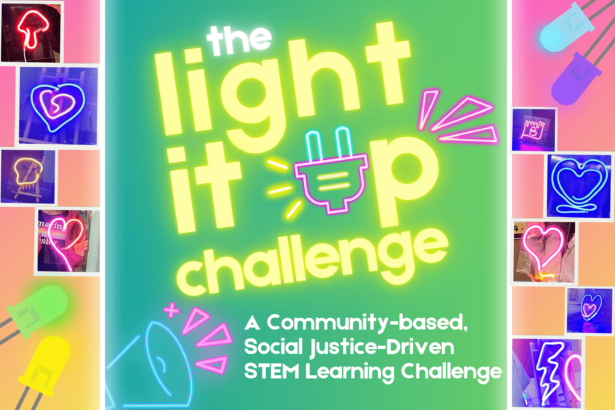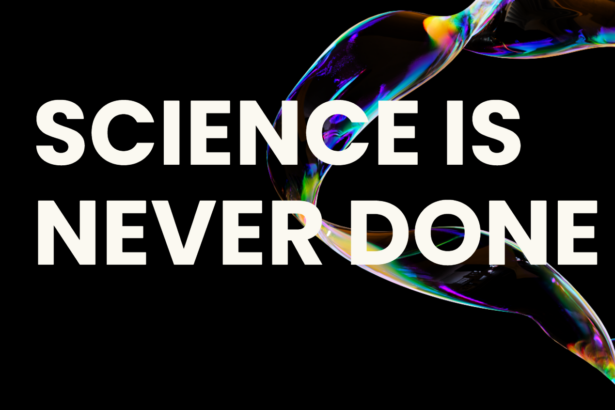Alex Sheehan & McKena Geiger
ChessMate is a ‘smart’ chess board that connects players remotely, combining the tactile experience of in-person chess with the connectivity of online play. Piece position, individual moves, and even tactics are communicated between boards over the internet, allowing for unique dialogues and conversations between players/learners facilitated entirely through their game boards. Unlike fully online digital platforms, ChessMate enhances attention and engagement by offering augmented, physical interactions and guidance. This unique hybrid approach not only makes games more immersive but also fosters deeper learning and social connection through a hands-on experience in the players’ physical space.
A Tinkerer’s Chessboard:
The ChessMate DIY Kit is designed with simple, accessible components, allowing anyone—from young novices to experienced engineers—to assemble their own interactive chess board while exploring circuitry, software, and hardware. In line with the theory of constructivism, learners are guided and supported through their own tinkering experience with the goal of producing a fully functional, ‘smart’ ChessMate board. With steps laid out and parts pre-soldered, the goal is for learners to experience the perfect balance between approachability and desirable difficulties. Planned expansions, like voice-activated move submission, automatic piece movement, and LED chat screen based communication, enable learners to take projects further and customize their experience and direction based on their interests and skill levels. ChessMate empowers users to build, learn, and personalize their endeavors, making it as unique as their own journey in engineering and chess.
Want to build your own smart chessboard? Download the ChessMate DIY guide below!
The Community’s Chessboard:
At its core, ChessMate is about fostering connection. We aim to break down cost barriers by setting up ChessMate boards in partnership with museums and community spaces worldwide, inviting people to connect across diverse environments, locations, and communities. Inspired by projects like the NYC-Dublin “portal,” ChessMate brings people together through shared curiosity and expands on the concept through hands-on exploration. By making this technology widely accessible, we hope to inspire a spirit of tinkering and bridging borders, creating opportunities for meaningful interactions in new and exciting ways.
A Learner’s Chessboard:
To make ChessMate accessible and enjoyable for all skill levels, we are introducing a “bumpers” mode—a guiding system similar to bumpers in bowling. This mode offers audio and visual cues while playing to support early learners when building their chess skills. Perhaps a player is subtly alerted to a potential trap they’re about to fall into, or simply that squares are highlighted if the piece picked up is able to move to them. By leveling the playing field, bumpers makes games more engaging and approachable by groups with different skill levels, allowing friends with varying amounts of experience to have fun together and feel more inclined to keep playing. This feature reinforces ChessMate’s mission to create inclusive, supportive learning environments through play.
Our Reflection
Each of the above directions for and expansions of ChessMate reflect our own learning journey. This was not necessarily a conscious effort on our end, but was the natural result of frequent failures, reflections, and feedback.

McKena:I joined the ChessMate project with no prior experience using an Arduino, coding in C++, or assembling circuits—but with plenty of excitement and (sometimes naive) confidence!
Alex had tackled the early hardships and failures prior to my joining. By the time I came on board, Alex had already modeled the circuitry, created the server, and written most of the Arduino code. Luckily, this was the “sweet spot” for a learner to join the project. With the chessboard conceptualized and planned, I could dive into manageable tasks like simple coding and wiring.
This smooth transition into working on ChessMate affirmed my decision to pivot from my original project. I knew as little about circuits and servers as I did about building an app (my initial idea), yet I found myself learning exponentially faster on ChessMate. Why?
- Learning is social: Working with a partner made a huge difference. I could riff ideas, talk through problems, and have concepts explained to me in real-time.
- Scaffolding and direction: Having Alex’s model circuitry and Arduino code as a blueprint gave me enough context to help assemble our circuits and contribute code in a language that was entirely new to me.
This experience highlighted a surprising realization: self-directed learning can sometimes clash with ambition. Structured collaboration and guidance can foster faster, more effective learning, especially in unfamiliar territory.
Alex: I had a vision of ChessMate before I even imagined getting accepted into and engaging with LDIT. It was a vision, inspired by a sci-fi movie I had seen when I was a kid, that I had dreamed of while locked away and isolated through the COVID-19 pandemic. I had the early experience working with Arduino and a close relationship with the Maker/tinker principles as it was the way I was introduced to and inspired to pursue computer science.
With these (rusty) rudimentary skills, I subconsciously defined a lot of the parameters, specs, and scope of the project from the beginning. Sensors and other hardware were limited to what I was aware existed years ago, what was taught to me through specific exercises, and what I had managed to search independently. These really only changed through trial and error through the learning design process. This was a costly experience, a lot of time and effort was spent failing over and over again and having to rewrite my own understanding without much guidance. Peer review/white boarding/rubber ducking was essential to this process and, unfortunately in my opinion, under utilized. The few times that I was able to corner someone who had some specific domain knowledge or experience, and conveyed a particular hurdle or issue, I usually came away with a revelation as to how to proceed. Not only that, but many of the coolest and most interesting features/iteration of design the project went through came from feedback and collaborations with groups around me.
Getting through this ordeal was rewarding, gratifying, and effective! I came away feeling proud of my designs and solutions, and absolutely learned skills that I will take on to use in any future Maker-esque type projects. All of these I want imparted directly onto learners who decide to engage with our product. This is fundamentally where the DIY kit came from, but the time/effort cost of what McKena and I had to put in was way too high to expect from learners/users- especially if our audience encompasses younger learners.
With this in mind, when marketing and building kits, we have a much better idea of what parts should come ‘pre-assembled’ and done for the user, and what should be left for the learner to struggle with. Soldering is not only finicky and requires a lot of dexterity, but the hobby can also be potentially dangerous to inexperienced practitioners and the equipment can be prohibitively expensive. The amount and scale of wires required for certain parts of the electronics can completely throw off any progress with the slightest bump or shuffle of the circuit if they’re not properly mounted, sorted, or soldered. There is even a precise amount of voltage and amps that the circuit requires which dictates exactly what kind of power supply is required. All of these things are examples of areas where we may have struggled a lot with, but don’t necessarily want our users to go through. On the flip side, providing different types of sensors (touch, infrared, weight, RFID, simple circuit), with documentation, instructions, and descriptions- and having the learner choose and explore which they like the best would be a wonderful desirable difficulty (and give the learner agency in their implementation and learning!). It’s not a coincidence that those types of decisions and learning that we did during the project brought the most satisfaction and pride.
Not surprisingly, difficulty and hardship are wonderful teachers. Making mistakes, attempting a particular technique or implementation and falling short, going back on decisions- we had to go through all of these endeavors while building our project prototype, and they are core to the tinker’s mindset. It would be a perfect world if we could magically make our users go through these things and come out the other side more informed, confident, and experienced, but our experience is critically different from what we envision our user’s experiences to be and I think we need to keep close attention to that. We had collaborators, and experts, and prior knowledge, and class deadlines to keep us on track. Motivation and eagerness is absolutely key to persevering through moments of setback, but maintaining that intrinsic motivation is key to our product being successful. For myself, the long standing dream (and fear of an encroaching deadline!) were plenty to keep me motivated, but we will need to make sure there is enough hand holding to support our learners.



